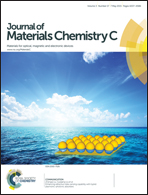Solution processing of highly conductive ruthenium and ruthenium oxide thin films from ruthenium–amine complexes†
Abstract
Highly conductive ruthenium metal (Ru0) thin films and ruthenium oxide (RuO2) films were prepared by a solution process. Solutions prepared from ruthenium(III) nitrosyl acetate and amines were spin-coated, and Ru0 and RuO2 thin films were formed after annealing in an inert atmosphere (nitrogen or vacuum) and oxygen, respectively. It was observed that amine-coordinated oxo-ruthenium clusters were formed in the precursor solution. The coordinated amines resulted in a change from oxidative decomposition to reductive decomposition of the ruthenium precursor under inert atmospheric conditions. The effects of different amine structures were compared, and alkanolamine and amino acids were found to produce Ru0 films of higher quality (lower resistivity and higher surface flatness) than alkyl amines with primary amines being preferred to secondary and tertiary ones. These results were correlated with the structures of ruthenium complexes revealed by methods including high-energy X-ray diffraction with total correlation function and pair distribution function analyses. The resistivity values of Ru0 and RuO2 thin films prepared from ruthenium–alkanolamine complexes were 2.1 × 10−5 and 4.3 × 10−4 Ω cm, respectively, similar to those of vacuum-processed Ru0 and RuO2 ones. The Ru0 film showed high stability against oxidation during further annealing in oxygen, even at nanometer-thickness (e.g., 25 nm).


 Please wait while we load your content...
Please wait while we load your content...